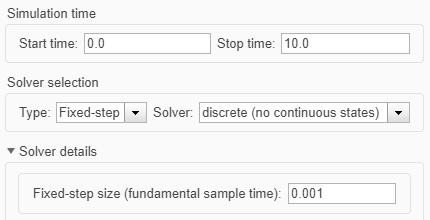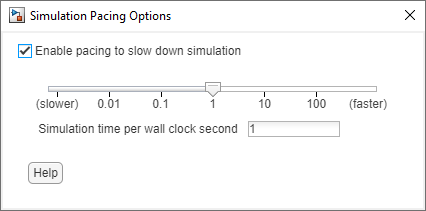이 페이지는 기계 번역을 사용하여 번역되었습니다. 최신 내용을 영문으로 보려면 여기를 클릭하십시오.
하드웨어 인터페이스 모델의 타이밍
시뮬레이션 시간
Simulink® 모델의 블록이 하드웨어 장치와 인터페이스해야 하는 경우, 시뮬레이션이 실시간 기준과 시뮬레이션 시간 기준에서 각각 소요되는 시간, 그리고 시뮬레이션 동안 하드웨어 인터페이스 블록이 실행되는 빈도와 횟수를 고려해야 할 수 있습니다. 일반적으로 하드웨어 통신 속도는 현실 세계 또는 "wall clock" 시간에 상대적입니다. 하드웨어 요구 사항에 맞게 시뮬레이션 기간, 블록 실행 속도, 시뮬레이션 속도를 조정할 수 있습니다. 이 항목에서는 블록 실행에 고정 스텝을 사용하는 경우 하드웨어 인터페이스 모델의 기본적인 타이밍 개념에 대해 설명합니다.
시뮬레이션은 시작 시간과 종료 시간으로 정의된 지속 시간을 갖습니다. 디폴트 지속 시간은 시뮬레이션 시간 단위(또는 시뮬레이션 초)로 10입니다. 이러한 시뮬레이션 초는 wall clock으로 측정한 실시간 초와 반드시 동일하지는 않습니다.
모델의 지속 시간을 조정하려면 모델 구성 파라미터 대화 상자를 엽니다. Simulink 툴스트립의 모델링 탭에서 모델 설정를 클릭합니다. 왼쪽 창에서 솔버를 선택하십시오. 시작 시간과 중지 시간 설정은 지속 시간을 정의합니다. 대부분의 경우, 시작 시간은 0.0이어야 하며, 중지 시간을 설정하여 원하는 시뮬레이션 지속 시간을 적용할 수 있습니다.
시뮬레이션이 실행되는 동안, 블록 실행을 위한 클로킹(clocking)은 일련의 시간 스텝에 의해 수행됩니다. 고정 시간 스텝 크기를 사용하는 자동 솔버 설정에서는, Simulink가 컴파일 중에 모델 내 모든 블록의 샘플 시간 파라미터 설정을 수용할 수 있는 시간 스텝 빈도를 계산합니다. 예를 들어, 모델 내 타이밍되는 모든 블록의 샘플 시간 설정이 0.01 또는 그 배수라면, 전체 모델에는 0.01의 시간 스텝 크기가 적합합니다.
블록 샘플 시간
하드웨어 장치와 인터페이스하는 모델의 경우 지정된 속도의 고정 시간 스텝을 선호할 수 있습니다. 예를 들어, 블록들의 타이밍 관계를 제어하기 위해 밀리초 단위의 분해능이 필요할 수 있습니다. 다음과 같이 타이밍 옵션을 설정합니다.
시작 시간:
0.0중지 시간:
10.0유형:
Fixed-step솔버:
discrete고정 스텝 크기:
0.001
이 이미지는 이러한 설정이 있는 대화 상자를 보여줍니다.

이 모델에서는 기본 샘플 시간 설정이 0.01인 블록이 10번째 시간 스텝마다 실행되며, 10초 시뮬레이션 동안 1001번 실행됩니다. 두 배의 속도로 실행해야 하는 또 다른 블록은 샘플 시간을 0.005로 설정해야 합니다.
참고
대부분의 경우 고정 스텝 크기 설정을 auto로 남겨두면 Simulink가 모든 블록 설정에 따라 적절한 기본 샘플 시간을 계산할 수 있습니다.
시뮬레이션 지속 시간이 "10 시뮬레이션 초"이고, 블록의 샘플 시간 기간이 "0.01 시뮬레이션 초"이므로, 해당 블록은 전체 시뮬레이션(첫 번째와 마지막 스텝 포함) 동안 1001번 실행됩니다. 시뮬레이션은 블록이 수행할 수 있는 최대한 빠른 속도로 실행되며, 1001번의 실행은 wall clock 시간 기준에서는 10초보다 훨씬 짧게 걸릴 수 있습니다. 따라서 실시간 시뮬레이션은 필요한 반복 횟수만큼 모델의 블록을 얼마나 빨리 실행할 수 있느냐에 따라 결정됩니다. 시뮬레이션의 목적은 종종 실제 상황에서보다 더 짧은 시간에 동작을 모델링하는 것입니다. 이런 경우, 블록 실행의 순서와 반복은 중요하지만 실세계 시간의 실제 길이는 중요하지 않을 수 있습니다.
모델 시뮬레이션 속도 조절
모델이 실세계 시간의 고정된 간격으로 어떤 작업을 반복하는 방식으로 하드웨어 장치와 상호 작용해야 하는 요구 사항이 있을 수 있습니다. 예를 들어, 블록이 온도계에서 데이터를 반복적으로 읽거나 외부 신호 생성기에 트리거를 보내 펄스 열을 출력할 수 있습니다.
블록 샘플 시간을 0.1로 설정하면 시뮬레이션 시간에서만 블록 실행 속도가 제어됩니다. 시뮬레이션 시간을 실제 시간과 연관시키려면, 시뮬레이션 속도 조절을 사용하여 시뮬레이션 속도를 늦춰 실세계 시간의 속도로 실행할 수 있습니다. 시뮬레이션 속도 조절 옵션 대화 상자에 액세스하려면 Simulink 툴스트립의 시뮬레이션 탭에서 실행 버튼 화살표를 클릭한 다음 시뮬레이션 속도 조절을 선택합니다.
시뮬레이션의 속도를 조절하려면 속도 조절을 활성화하여 시뮬레이션 속도를 늦추기를 선택합니다. 기본적으로 시뮬레이션 시간과 실시간의 비율은 1입니다. 이는 모델을 1초의 시뮬레이션 시간 동안 시뮬레이션하는 것이 실시간으로 1초가 걸리도록 조절된다는 의미입니다.

이러한 속도 조절 설정을 사용하면, 블록의 샘플 시간 0.1은 대략 wall clock 0.1 초와 같으며, 초당 10번의 블록 실행이 수행됩니다. 따라서 0.1 시뮬레이션 초마다 장치 출력 펄스를 생성하는 블록은 이제 wall clock 1초당 10개의 펄스를 생성합니다.
Wall clock 시간의 속도를 더욱 정밀하게 조절해야 하는 사례에 대한 자세한 내용은 실시간 시뮬레이션 및 테스트 항목을 참조하십시오.
참고 항목
툴
- 시뮬레이션 속도 조절 옵션 (Simulink)
도움말 항목
- 샘플 시간이란? (Simulink)